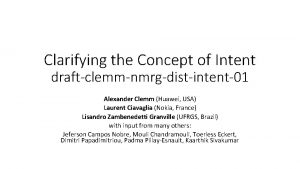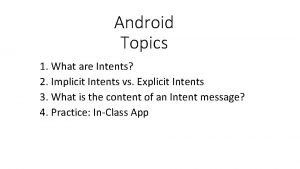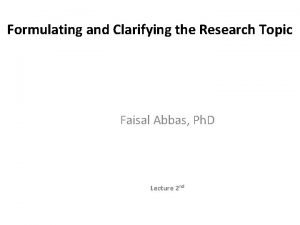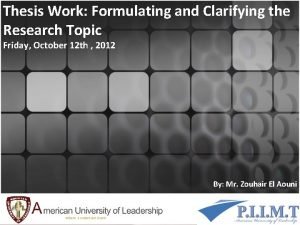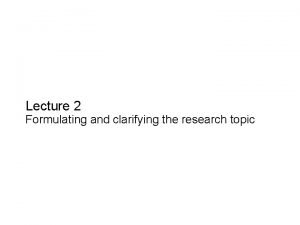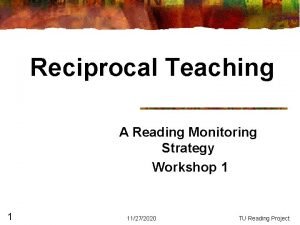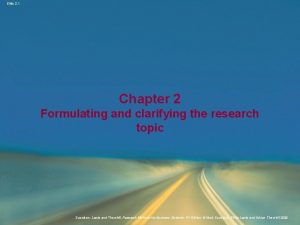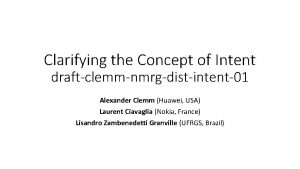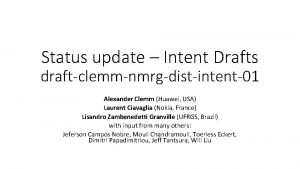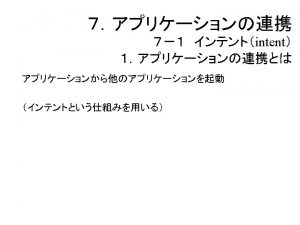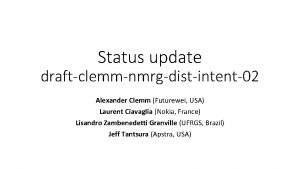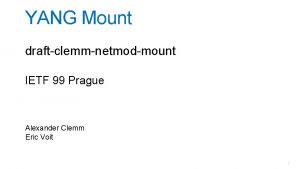Clarifying the Concept of Intent draftclemmnmrgdistintent01 Alexander Clemm










- Slides: 10

Clarifying the Concept of Intent draft-clemm-nmrg-dist-intent-01 Alexander Clemm (Huawei, USA) Laurent Ciavaglia (Nokia, France) Lisandro Zambenedetti Granville (UFRGS, Brazil) with input from many others: Jeferson Campos Nobre, Mouli Chandramouli, Toerless Eckert, Dimitri Papadimitriou, Padma Pillay-Esnault, Kaarthik Sivakumar

Status update • Initial discussions on this at IETF 100/101 + NMRG interim at IFIP/IEEE NOMS 2018 • Per discussions, the first in a suite of eventually three drafts: (1) Terminology – Definitions and Concepts: Intent vs policy vs service models, etc This draft (2) Intent definition – Expressing Intent (draft TBD) - Human – Machine interface aspects - Relationship to data models – can you use YANG? - Layer interdependencies (3) Basic intent architecture and framework/reference architecture draft-moulchan-nmrg-network-intent-concepts - How to render intent - How to validate network behaves “as intended” • Various updates from -00: editorial updates and tightening, added references 2

What is this about? • “Intent-Defined Networking” is one of the recent industry buzzwords • Basic idea: Define what you want, not how to do it • This sounds good, but is this idea really new? (rhetorical question) • Policy-based management: Define high-level policies, leave it to policy renderers to do the rest • Service models and service provisioning: Define services & leave mapping of the service to low-level configurations, resource allocations, and objects to a flow-through provisioning system • Information hierarchies and abstractions are known concepts and common practice for service providers today (e. g. TMForum e. TOM / Business Process Model, ITU-T TMN reference model (management layers + FCAPS) • So, what is intent, really? • How does it differ from what came before? • Is Intent a reincarnation of policy? Of service models? Is intent synonymous, or different? Why all those terms and how do they relate? • If it is different: how so? What are the implications? 3

Existing Frameworks (that also make extensive use of management abstractions and hierarchies) Source: ITU-T

Existing Frameworks (that also make extensive use of management abstractions and hierarchies) Manage overall business aspects supported by the provided services: revenue forecast, supply chains, corporate compliance Business Management Service Management Network Management Element Management Network Element aka “TMN Pyramid” Source: ITU-T Manage services provided by the network: service level management, service order provisioning Manage network connectivity aspects: topology, links, end-toend paths Manage aspects of individual devices: monitor ports, download a patch, set a configuration parameter Management agent, embedded management intelligence

Existing Frameworks (that also make extensive use of management abstractions and hierarchies) e. TOM – enhanced Telecoms Operations Map (TM Forum GB 921: Business Process Framework) Source: TMF

Differences between concepts and terms • Service Models: • Describe instances of services that are provided to customers (see e. g. RFC 8309) • Service instantiation involves orchestration and mapping to underlying resources (user does not specify how to add, modify, remove a service – the system does it) • Machine-to-machine interactions; flow-through provisioning • Typically centralized • Policy: • • Set of rules (event/condition/action or variations) Imperative: specify how to act / what to do under what given circumstances (largely) machine-to-machine (but also devops-to-machine) interactions Policy rendering: abstraction (and homogenization) of low-level knobs and data • Intent: • Declarative: Define desired outcomes and high-level operational goals • Interactions between humans and machines • Network (or Intent-Based Management System) renders intent – two aspects: information abstraction and determination of logic • Centralized and decentralized flavors

Discussion items • Define intent narrowly (only “new” concepts) or broadly • Putting things into a common context vs. guilty of “intent-washing” • Operational intent – service intent – flow intent • Intent at different hierarchy layers (at device/network/service level), distinguished by actor (NOC operator, user, administrator) • Intent functional areas: e. g. intent fulfilment vs intent validation (or assurance? ) • Intent compliance assessment and monitoring • Service assurance and service level management (“intent washing”) • Intent levels • • Intent at multiple levels in a hierarchy: e. g. service vs network infra Intent of multiple roles: e. g. NOC operator, admin, end user Intent at multiple levels of granularity: e. g. flow intent Intent reconciliation, intent conflict detection • Possible expansion of scope to intent reference architecture?

Discussion items (contd) • Intent articulation and human-machine aspects • Type of actor impacts the type of interaction and interface • Natural language processing – infer meaning • Dialogue vs command • Dealing with under-specification (and over-specification) • Conflict avoidance • Resolution of ambiguities • Technical solutions are beyond scope of this particular draft, but important for distinction of what makes intent “unique” • “Can intent be expressed as YANG data model? ” • Beyond scope but relevant for IRTF: possible research topics • Human-machine interaction • Intent compliance assessment • Intent conflict detection, reconciliation, negotiation • This is ongoing work & the discussion is just getting started • Next step: RG adoption?

Thank you!
 Nmrg patch
Nmrg patch Implicit vs explicit intent
Implicit vs explicit intent Virginia eliza clemm
Virginia eliza clemm Formulating and clarifying the research topic
Formulating and clarifying the research topic Secondary research question
Secondary research question Formulating and clarifying the research topic
Formulating and clarifying the research topic Spellers clarifying phrase
Spellers clarifying phrase Formulating and clarifying the research topic
Formulating and clarifying the research topic What is this font?
What is this font? Purposeful listening meaning
Purposeful listening meaning Formulating and clarifying the research topic
Formulating and clarifying the research topic
